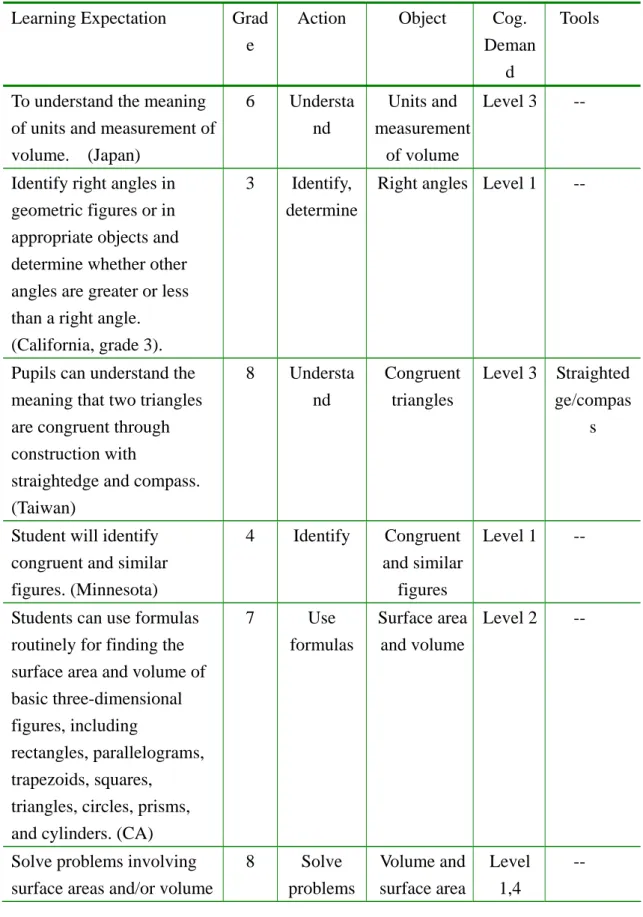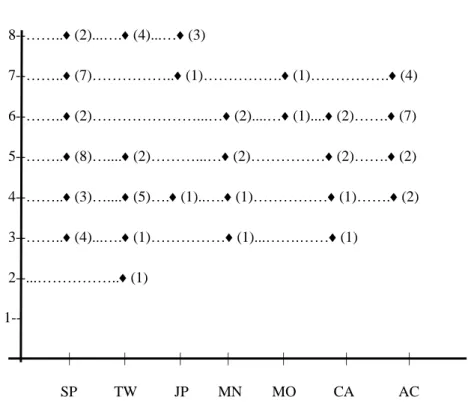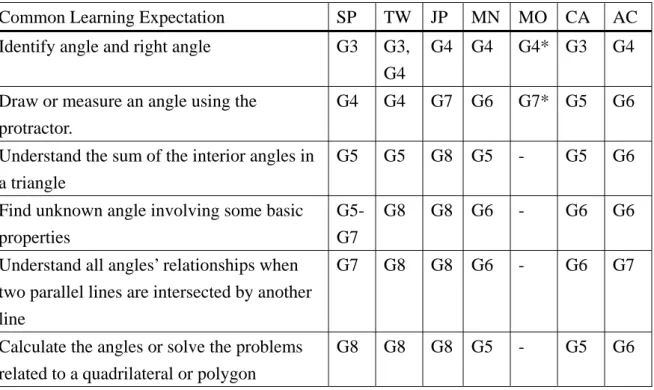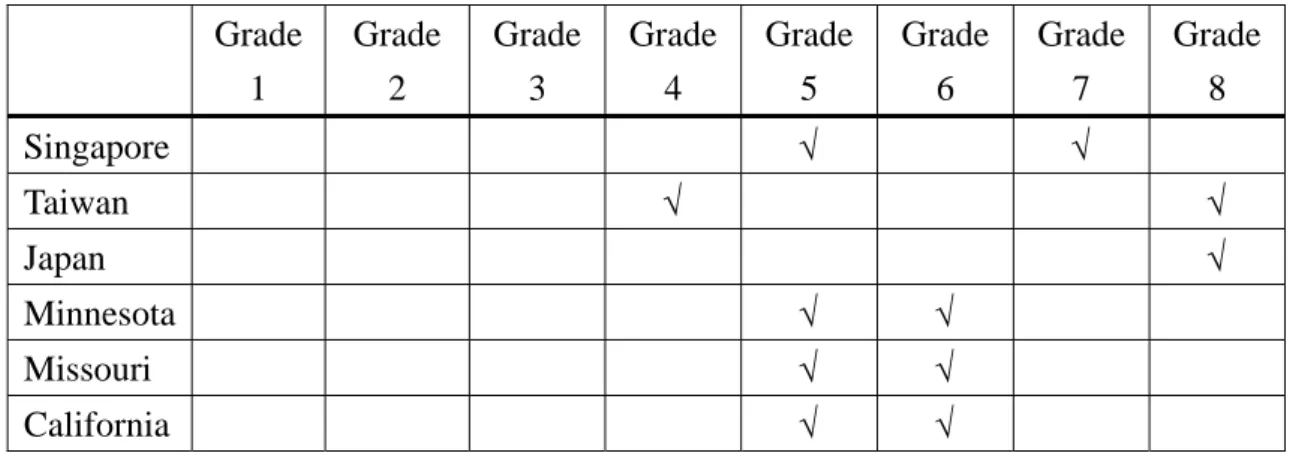Investigating the Learning Expectations related to Grade 1-8
Geometry in Some Asian Countries and U.S. States
Jung-Chih Chen
National Chiayi University, Taiwan jcchen@mail.ncyu.edu.tw
Abstract
This study analyzes learning goals in grade 1-8 geometry across several U.S. states and high performing TIMSS Asian countries, including Singapore, Taiwan and Japan. In order to shorten this paper, only one topic-angle within the geometry strand was carefully analyzed.
Based on the official curriculum documents, results of this study indicate that the content, grade placement and cognitive level of learning expectations related to selected geometry topics vary markedly across documents.
To be precise, some documents such as the California and Achieve documents include more advanced topics within their 1-8 curriculum framework and introduce them earlier than the other documents. In addition, the Singapore document places comparably more emphasis on the topic of “angle” and less on “coordinate geometry” and “parallelism/perpendicularity.” Furthermore, the Missouri document emphasizes on “coordinate geometry” and “similarity” topics and de-emphasizes on the topics of “angle” and “parallelism/perpendicularity” than the other documents reviewed. In the meantime, considerable differences emerge across each topic. In sum, analyses from this study have provided a clear picture about the “angle” topic from each document.
Key Words: Curriculum Framework, Learning Expectation, NCLB, OTL, TIMSS.
This paper is partially revised from the author’s dissertation, supervised by Dr. Barbara J. Reys at the University of Missouri-Columbia, USA.
Introduction
Many international assessments support the view that many students in the United States are not learning the mathematics they need or are expected to learn, particularly when compared to peers in others countries (Beaton et al., 1996; Kenney & Silver, 1997; Mullis et al., 1997). Although the reasons for these differences are complex, educators generally agree that opportunity to learn (OTL) is a contributing, if not major, factor. Floden (2002) argued that “If OTL is not taken into account, its effect may be mistakenly attributed to some other attribute of the educational system.”
Most educators acknowledge that various dimensions of the educational system, such as state or local policies, textbooks, classroom organization and teacher knowledge, have an influence on students’ opportunity to learn and the quality of instruction students receive. As noted by authors of The Underachieving
Curriculum (McKnight et al., 1987):
“One of the main functions of curriculum, as intended and as implemented, is to distribute the content of the curriculum throughout the days and years of schooling according to a coherent and reasoned set of goals” (page 85).
The Third International Mathematics and Science Study (TIMSS) used a model called Potential Educational Experience (see Figure 1) to capture different aspects of how educational opportunities are shaped and how they are potentially related. In this model, curriculum goals at the system level represent the “intended curriculum.” Historically, the intended curriculum has not been described in details within the United States.
International studies of mathematics and science achievement have consistently reported that students in Asian countries such as Singapore, Taiwan and Japan demonstrate higher levels of mathematics achievement than students in the United States. Especially, based on evidence from reports of TIMSS and the National
Assessment of Educational Progress (NAEP), geometry is an area of weakness for U.S. students (Kloosterman , 2004). However, little is known about how the curricula described in the documents differ from state or Asian country curriculum frameworks.
Figure1: The Model of Potential Educational Experiences.
(Source: Schmidt et al., 1997).
The passage of the No Child Left Behind (NCLB) legislation in 2002 prompted many states to identify grade-by-grade learning expectations (LEs) and align these expectations to mandated state annual assessments in grades 3-8. In fact, as of June 2005, at least 44 states have official curriculum documents that specify grade-by-grade learning expectations in mathematics (Reys et al., 2005).
More recently, Achieve, Inc., an independent nonprofit organization created by governors and corporate leaders to help raise standards and performance in American schools, released a grade-by-grade curriculum framework for K-8 (Achieve, Inc.,
2004). The Achieve document was also reviewed for this study as it represents a national proposal including grade-by-grade learning expectations, organized by strand, from a U.S. organizational group. In fact, special attention in this study is placed on the following research question:
To what extent and in what ways are learning expectations associated with geometry strand similar or different in emphasis and grade placement in selected Asian countries and U.S. states as described in the official standards of mathematics curriculum documents?
This analysis may partially explain differences in performance among students in these countries and states, particularly if the intended curriculum is an important contributor to what students have an opportunity to learn.
Methodology
The selection of countries for this study was based on the performance on the TIMSS assessment. The selection of U.S. states was based on student performance on the NAEP-2000 assessment and on the evaluation of official state curriculum documents by the Fordham Foundation. Geometry strand was selected for analysis because U.S. students perform relatively poorly on items related to this strand, compared to students in other countries and compared to their performance on other strands of mathematics.
A coding system was developed which consisted of the general categories: Action,
Object, Cognitive Domain (SEC), and Tools. For each learning expectation in the
geometry strand of the curriculum documents, the following information was coded: z Object-the main noun(s) in the learning expectation
z Action-the main verb(s) in the learning expectation
z Tools-equipment specified for use within the learning expectation
based on the Survey of Enacted Curriculum protocol (CCSSO, 1999). Table 1 provides a sample of how learning expectations were coded in this study.
Table 1: Sample of coded learning expectations
Learning Expectation Grad e
Action Object Cog. Deman
d
Tools
To understand the meaning of units and measurement of volume. (Japan) 6 Understa nd Units and measurement of volume Level 3 --
Identify right angles in geometric figures or in appropriate objects and determine whether other angles are greater or less than a right angle. (California, grade 3).
3 Identify, determine
Right angles Level 1 --
Pupils can understand the meaning that two triangles are congruent through construction with
straightedge and compass. (Taiwan) 8 Understa nd Congruent triangles Level 3 Straighted ge/compas s
Student will identify congruent and similar figures. (Minnesota)
4 Identify Congruent and similar
figures
Level 1 --
Students can use formulas routinely for finding the surface area and volume of basic three-dimensional figures, including
rectangles, parallelograms, trapezoids, squares,
triangles, circles, prisms, and cylinders. (CA)
7 Use formulas
Surface area and volume
Level 2 --
Solve problems involving surface areas and/or volume
8 Solve problems Volume and surface area Level 1,4 --
of a rectangular or triangular prism, or cylinder. (Missouri) Find the volumes and surface areas of cubes, cuboids, prisms and cylinders. (Singapore)
7 Find Volume and
surface area
Level 2
Analysis of the Learning Expectations in Geometric Topics
Recall that the general strategy for analysis was based on the “topic tracing” method developed by TIMSS researchers. That is, for each topic, all LEs related to that topic within each curriculum document (3 countries-Singapore, Taiwan, Japan; 3 states-Minnesota, Missouri, California; Achieve) were identified and the following information was compiled:
• A description of the focus of the topic by grade level and document. • The grade where the topic is intended to be first introduced to students.
• The range of grades during which instruction was intended to take place on the topic.
• Any grade for which the topic was to be a special emphasis.
The main goal of this analysis was to describe the focus of specific content, depth of coverage, and grade placement where particular LEs were emphasized.
Summary of Learning Expectations Related to “Angle”
The concept of “Angle” was one of topics analyzed within the geometry strand. Based on the analysis, a summary of the content emphasis and grade placement for this topic was provided. In addition, similarities and differences in emphasis and grade placement across the seven documents were noted.
In all 73 learning expectations related to angle were identified across the seven documents. The earliest LE appears in grade 2 of the Taiwan document and states:
Pupils can recognize an angle, straight line, and plane (containing solid shapes) in their daily life. (Taiwan, grade 2)
Other early grade angle LEs include:
Identify right angles in geometric figures or in appropriate objects and determine whether other angles are greater or less than a right angle. (California, grade 3).
Student will identify, describe, and classify two-dimensional shapes according to number and length of sides and kinds of angles. (Minnesota, grade 3). Recognize that angles on a straight line add up to 180 degrees and that angles around a point add up to 360 degrees. (Achieve, grade 5)
A sample of Grade 7 and 8 LEs related to angles includes:
To determine and verify logically the relationship between inscribed angles and central angles through observation and experimentation. (Japan, grade 8).
Describe relationships between corresponding sides, corresponding angles, and corresponding perimeters of similar polygons. (Missouri, grade 7). Pupils should be able to calculate the sum of interior angles of a polygon and the sum of exterior angles of a polygon. (Singapore, grade 8).
Grade 8--……..♦(2)...….♦(4)...…♦(3) 7--……..♦(7)………..♦(1)……….♦(1)……….♦(4) 6--……..♦(2)………...…♦(2)....…♦(1)....♦(2)…….♦(7) 5--……..♦(8)…....♦(2)………...…♦(2)………♦(2)…….♦(2) 4--……..♦(3)…....♦(5)….♦(1)..….♦(1)………♦(1)…….♦(2) 3--……..♦(4)...….♦(1)………♦(1)...…….……♦(1) 2--...………..♦(1) 1-- | | | | | | | SP TW JP MN MO CA AC
Figure 2 : Number and grade placement of learning expectations related to “Angle” within Geometry strand.
(Remark: The number inside parentheses indicates the number of learning expectations).
Common learning expectations related to angle include: identifying and/or drawing special angles (e.g., right, straight, acute, obtuse, complimentary), comparing angles, drawing and measuring angles (with and without tools), understanding relationships among particular angles (e.g., vertical angles or angles formed by parallel lines intersected by a third line), finding unknown angles based on properties (e.g., sum of angles of triangle), classifying polygons based on size and relationship of angles, constructing angle bisectors, etc.
Six common learning goals were noted within the set of LEs (see Table 2). For example, in seven of the documents, students are expected to identify angles, including special angles such as a right angle and this expectation occurs at grade 3 or 4 across these seven documents. On the other hand, the LE to draw or measure an angle with a protractor, while common to seven documents, occurs at grade four in
Singapore and Taiwan, grade 5 in California, but at grade 6 in Minnesota and Achieve, and grade 7 in Japan. Note that the learning expectations in Missouri are kind of addressed in generalizations such as “Classify 2-D and 3-D shapes based on their properties” or “Analyze characteristics and properties of 2-D and 3-D geometric shapes.” Only two LEs in Missouri are specifically related to the angle, that is, to describe the relationships of similar triangles and similar polygons.
Table 2 : Common learning expectations related to the “Angle” topic
Common Learning Expectation SP TW JP MN MO CA AC Identify angle and right angle G3 G3,
G4
G4 G4 G4* G3 G4
Draw or measure an angle using the protractor.
G4 G4 G7 G6 G7* G5 G6
Understand the sum of the interior angles in a triangle
G5 G5 G8 G5 - G5 G6
Find unknown angle involving some basic properties
G5-G7
G8 G8 G6 - G6 G6
Understand all angles’ relationships when two parallel lines are intersected by another line
G7 G8 G8 G6 - G6 G7
Calculate the angles or solve the problems related to a quadrilateral or polygon
G8 G8 G8 G5 - G5 G6
Remarks: 1. G3 means the learning expectation is provided for Grade 3. 2. “*” indicates this LE is found in Measurement strand. 3. “-”indicates no specific statement in the LEs.
Among the 73 LEs some were noted only within one or two documents. For example, the Singapore document includes the following LEs not found in other documents:
To estimate the size of angle (Singapore, grade 4).
opposite angles (Singapore, grade 5).
To identify the vertically opposite angles, and to recognize they are equal (Singapore, grade 5).
Likewise, the Taiwan, Japan, Missouri and Achieve documents include LEs not found in other documents. These include:
To understand the relationships between side and angle in a triangle (Taiwan, grade 8).
To determine and verify the relationships between inscribed angles and central angles (Japan, grade 8).
The rigid motion doesn’t change the length and angle of polygonal figures (Achieve, grade 6).
Criteria such as SSS, SAS and AA for similar triangles are addressed (Achieve, grade 7).
Based on the analyses of the collected documents, Table 3 summarizes the grade at which the topic of angle receives special emphasis. “Special emphasis” indicates that the common learning expectations of this topic are addressed and that a substantial amount of time (in proportion to other topics from geometry) is devoted to angle. In general, attention to this topic is concentrated in Grades 4 - 8.
Table 3 : Grades for special emphasis on “Angle” topic
Grade 1 Grade 2 Grade 3 Grade 4 Grade 5 Grade 6 Grade 7 Grade 8 Singapore √ √ Taiwan √ √ Japan √ Minnesota √ √ Missouri √ √ California √ √
Achieve √ √ Summary of Emphasis on Angle by Country/State
As noted in Figure 2, the Singapore document includes the largest number of LEs related to angle (26 in all) with the greatest emphasis in grades 5 and 7. Students in Grade 3 and Grade 4 identify angles in 2-D shapes and draw or measure angles using a protractor. Using properties of geometric figures to find unknown angles is an important theme among the set of LEs, particularly from Grade 5 through 7. In addition, students in Grade 7 are expected to use tools to construct angle bisectors and to measure angles and students in Grade 8 are expected to calculate the sum of angles or unknown angles related to a polygon.
In contrast, Taiwan has fewer LEs related to angle. Most of these learning expectations emphasize understanding the meaning of “angle,” “right angle,” “rotating an angle,” “unit degree,” “180 degrees,” and “360 degrees.” In other words, these LEs related to basic terms are mostly categorized into the low levels in cognitive domain.
Minnesota has a very condensed set of LEs related to angle (6 LEs spanning grades 3-6). In Grade 3 and Grade 4, students classify 2-D shapes based on their angles and identify right angles. In Grade 5 and Grade 6, students focus on the sum of the angles in triangles and quadrilaterals. In addition, students solve real world problems using knowledge of angles, and learn to measure or draw the angles using common tools such as ruler, compass, protractor or software.
In Japan, the main emphasis for this topic is in Grades 7 and Grade 8. Students in Grade 7 will learn and use the basic methods to draw the angle bisectors. In Grade 8, emphasis is on the properties of parallel lines and angles and properties of the angles of polygons. Through observation and experimentation, students determine and verify
the relationship between inscribed angles and central angles.
Only two learning expectations on this topic were identified in the Missouri document. One at grade 6 and the other at grade 7. In both cases, the focus is on relationships between corresponding angles and the length of corresponding sides (for similar triangles in grade 6 and similar polygons in grade 7).
The primary emphasis on angles in the California document is at grades 5 and 6. Students in Grade 5 are expected to measure and draw angles and know the sum of the interior angles of triangles and quadrilaterals. Students in Grade 6 are expected to solve problems using some properties of angles.
In the Achieve document, LEs related to angle appear in Grade 4 through Grade 7. In Grade 4 and Grade 5, students identify acute, obtuse and right angles. They also focus on the degree as a unit of measure and gain facility in measuring angles using degree as the unit. Students in Grade 6 have the opportunity to learn some critical properties of transformation, congruent triangles and symmetric figures. Finally, students in Grade 7 recognize equal angles, such as corresponding angles and alternate interior angles, as well as several criteria of similar triangles.
Weight of Topic Within Geometry Strand
In order to gauge the relative emphasis (weight) of angle within the Geometry strand, Table 4 provides a summary of the number of learning expectation associated with angle, and the percent with respect to the total number of LEs within the
Geometry strand.
Table 4 : The Weight of topic-Angle.
SP TW JP MN MO CA AC
Number of
LEs 26 13 5 6 2 6 15
Total
Geometric LEs
Remark: The CA document includes Geometry & Measurement together.
This table indicates that Singapore has the highest percentage related to this topic within the Geometry strand. By contrast, Missouri has relatively low weight. In general, the Asian countries have higher weight than the U.S. states in this topic. Cognitive Level of Learning Expectations Related to Angle
Recall that the cognitive level for each learning expectation was coded using the Survey of Enacted Curriculum (SEC) protocol (CCSSO, 1999). Table 5 provides a summary of the distribution of levels in cognitive demand. Note that each LE may be coded into double levels.
Table 5 : Number and Distribution of Level in Cognitive Domain for LEs related
to Angle SEC Country/State N of LEs Memorize Fact, Def. &Formula Perform Procedures Demonstrate Understanding Conjecture, Generalize & Prove Solve Problems, Connect Singapore 26 19% 62% 19% - - Taiwan 13 39% 8% 46% - 8% Japan 5 40% 20% 60% 40% - Minnesota 6 50% 17% 33% - 17% Missouri 2 - - 100% - - California 6 67% 17% - - 33% Achieve 15 40% 33% 27% - -
Table 5 has provided evidence that most LEs under this topic are categorized into the first three levels of cognitive domain. Particularly enough, all countries/states except Japan have no learning expectations categorized into the higher level of “Conjecture, Generalize & Prove” in the SEC cognitive domain.
Reference to Use of Tools
Within the set of angle LEs, reference is made to a variety of tools including: ruler, set-squares, protractors, compasses, straightedge, and software. Although no specific tools about this topic are mentioned in the Japanese document, drawing figures involving bisecting angles are addressed. Also, Missouri made no mention of a tool specification for this topic.
Concluding Remarks
Learning expectations (LEs) represent what students are expected to learn. Based on the data analyses, researcher realizes that some content similarities and differences of LEs related to “angle” do exist in different countries/states. Accordingly, these differences raise the “opportunity to learn” issue which may also influence student achievement.
This examination revealed that all Asian countries have higher “angle” weights within the Geometry strand than the U.S. states. Meanwhile, under this topic, many LEs in ACHIEVE, and the states of California and Minnesota are categorized into lower level “Memorize fact, definition, formula” of cognitive domain. Comparably, the majority of LEs in Japan are categorized into higher levels of cognitive domain. These results may suggest that high level LEs that favor conceptual understanding have a close link and distinct benefits for student achievement. All these findings are perhaps worthy of our attention.
To conclude, “curriculum” is an important channel of influence to consider in understanding differences in student performance on measures such as TIMSS. Analyses from this study have provided indicators to understand the “Angle” topic from different countries/states, including the range of grades during which instruction was intended to take place on the topic, the “Angle” weights within the Geometry strand, the grades of special emphasis on this topic, and grade by grade cognitive
levels from SEC. All these indicators, together with the common learning
expectations listed in Table 2, mostly provide a broad profile of the attention given to angle across these countries and states. Future research may pursue the impact of curriculum documents on teacher practice.
References
Achieve, Inc., (2004). Mathematics Achievement Partnership, K-8 Mathematics Expectations, December 2004 Draft. Available : http://www.achieve.org/.
Beaton, A.E., Mullis, Ina V.S., Martin, M.O., Gonzalez, E.J., Kelly, D.L., Smith, T.A. (1996). Mathematics Achievement in the Middle School Years: IEA’s Third International Mathematics and Science Study (TIMSS). Chestnut Hill, Mass: Boston College, TIMSS International Study Center.
CCSSO, (1999). Survey of Instructional Content Grades K-8 Mathematics. Washington, DC: Council of Chief State School Officers.
Floden, R.E. (2002). The measurement of opportunity to learn. In Andrew C. Porter and Adam Gamoran (Eds.), Methodological advances in cross-national surveys of educational achievement. Washington, DC: National Academy Press.
Kenney, P.A., & Silver, E.A. (1997). Results from the Sixth Mathematics Assessment of the National Assessment of Educational Progress. Reston, VA: NCTM.
Kloosterman, Peter & Lester, Frank K. (2004). Results and interpretations of the
1990-2000 mathematics assessments of the national assessment of educational progress. Reston, VA:NCTM.
McKnight, C.C., Crosswhite, F.J., Dossey, J.A., Kifer, E., Swafford, J.O., Travers, K.J., Cooney, T.J. (1987). The Underachieving Curriculum: Assessing U.S. School Mathematics from an International Perspective. Stipes Publishing Company, Champaign, Illinois.
Mullis, I.V.S., Martin, M.O., Beaton, A.E., Gonzales, E.J., Kelly, D.L., and Smith, T.A. (1997). Mathematics Achievement in the Primary School Years: IEA’s Third
International Mathematics and Science Study (TIMSS). Chestnut Hill, Mass: Boston
National Council of Teachers of Mathematics. (2000). Principles and Standards for
School Mathematics. Reston, VA: Author.
Reys, B.J., Dingman, S., Sutter, A., Teuscher, D. (2005). Development of state-level mathematics curriculum documents: Report of a survey. Prepared by the Center for the Study of Mathematics Curriculum. Available : http://www.mathcurriculumcenter.org/news.html.
Schmidt, W.H., McKnight, C.C., Valverde, G.A., Houang, R.T., Wiley, D.E. (1997).
Many Visions, Many Aims, Volume 1. A cross-National Investigation of Curricular Intentions in School Mathematics. TIMSS, Boston:Kluwer Academic Publishers.
The No Child Left Behind Act. (2001). Public Law No. 107-110. Retrieved January 13, 2005, from http://www.ed.gov/policy/elsec/leg/esea02/index.html.





